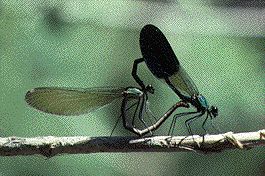Bushbabies and many other primates have monstrous penises – many of them look like medieval torture instruments. They have spikes and knobs and bristles and are often twisted into weird and sinister shapes. By comparison, the human penis is dull, notable only for its girth.
Among primates as among insects, it is a rule of thumb that in species where females consort with one male at a time, penises are small and uninteresting. Take the gorilla – a huge guy with a little teeny weenie. A male gorilla can weigh 210kg (460lbs), but his penis is a measly 5cm (2in) long and entirely devoid of knobs and spikes. The Argentine lake duck puts him to shame. The duck is small, but his penis, which rivals that of the ostrich, is 20cm (8in) long – and it has spines. But then a male gorilla generally presides over a small group and does not often have to worry about other fellows’ sperm.
Damselflies, on the other hand, have evolved some of the fanciest penises around. A typical damselfly penis has a balloon – an inflatable bulb – and two horns at the tip, plus long bristles down the sides. In the black-winged damselfly, Calopteryx maculate, the male uses this device to scour sperm from inside a female before depositing his own. But in the related Calopteryx haemorrhoidalis asturica, he uses his penis as an instrument of persuasion: by stimulating her in the proper manner, he can induce her to eject sperm from previous lovers.

Meanwhile, the moth Olceclostera seraphica has genitals that resemble a musical instrument: the male rubs one part of his privates against another, producing vibrations with which to thrill his mate.
In contrast, among termites the female typically mates with only one male – and male termites have plain, unadorned genitalia that do not differ much from one species to the next.


No comments:
Post a Comment